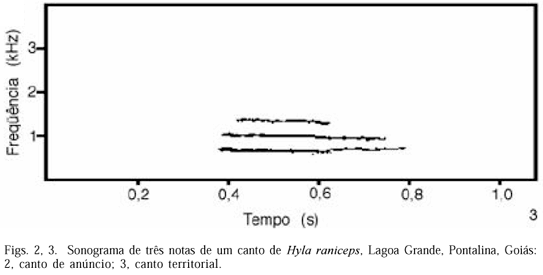The vocalizations of H. raniceps (Cope, 1826) and their functions are described, including an analysis of the influence of temperature, weight, or SVL (snout-vent length) of males on the acoustic parameters. The vocalizations were recorded in three areas in Fazenda Lagoa Grande, Municipality of Pontalina, State of Goiás, central Brazil. Males began their vocalizations just before sunset, extending them, in some cases, to dawn of the following day. The peak of activities happened between 21h and 23h. The height of calling sites varied plenty, being the position horizontal in about 50% of them. Males defended sites in different areas during consecutive nights. Rain and strong winds interrupted the calling activities. Males emitted three vocalizations: advertisement, territorial and distress calls. The advertisement call has pulsionated structures and it is the most common, being emitted in the presence/absence of females. Significant correlation was found between number of notes and air temperature, notes duration and both male weight and air temperature, calling rate and both male SVL or weight, and frequency and male weight.
Anura; Hylidae; Hyla; vocalization; acoustic parameters





